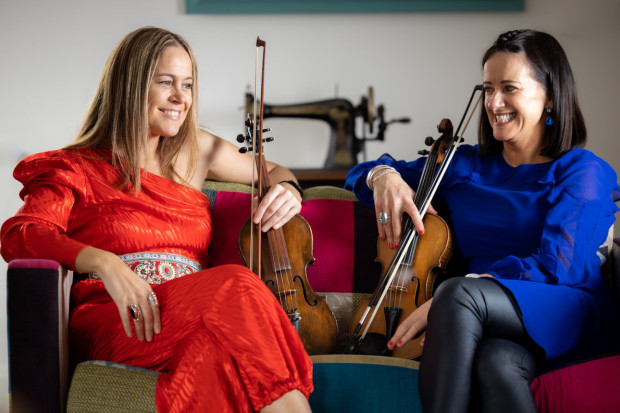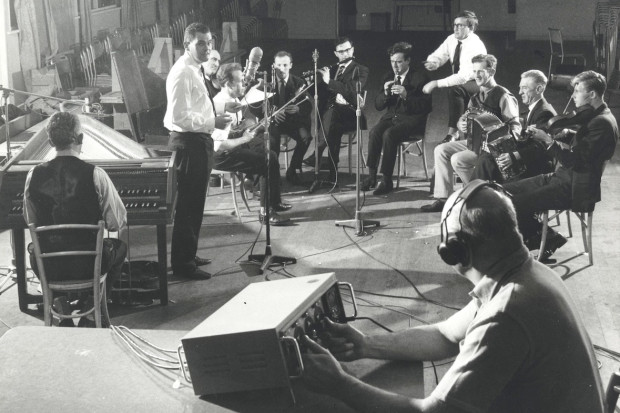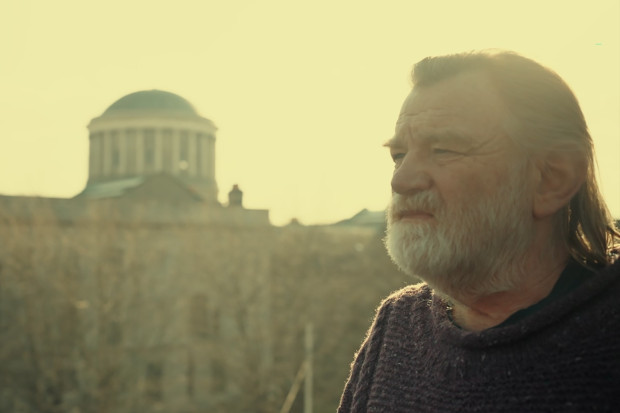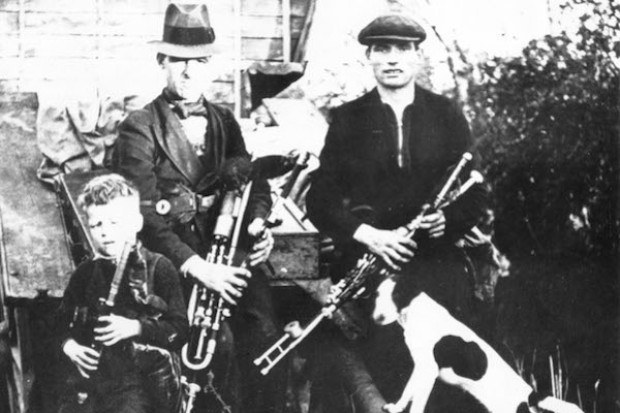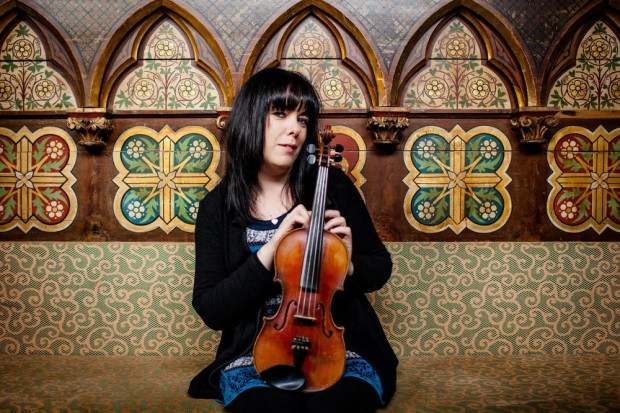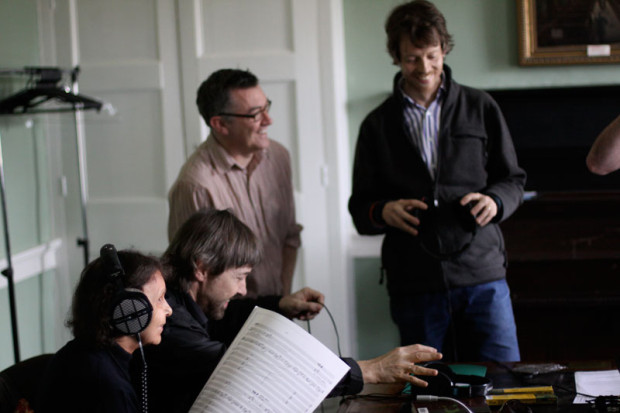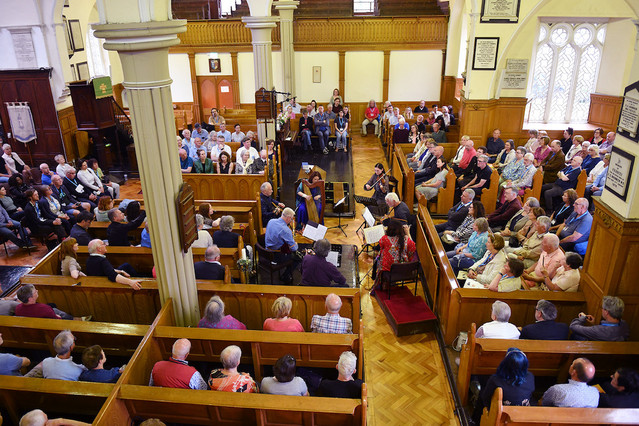
The performance of 'In C Irish' at the Louth Contemporary Music Festival in June – now issued as a recording. (Photo: Ken Finegan, Newspics Photography)
In the Tradition of Terry Riley
Terry Riley’s In C is a lodestone of twentieth-century musical minimalism, while also crossing over and gaining recognition outside of its original subcultural context. First performed in 1964 by an auspicious group of musicians (including Steve Reich and Pauline Oliveros), its fluid and open structure – it can be played by any combination of musicians – makes it hugely accessible to performers, including those who have responded to its open structure in imaginative and sometimes unexpected ways.
It is on one level a very simple piece. Riley wrote 53 mostly short musical phrases or cells. All of the musicians begin with the first phrase, repeating it as often as they choose, before moving to the next phrase, which they are again free to repeat ad lib. The players progress through all the phrases consecutively, and are guided by what is known as ‘The Pulse’, a repeated octave C in a high register. Riley’s performance instructions emphasise the need for performers to listen to each other, and balance between getting too far ahead or behind, or playing too much in alignment. Every performance thus creates different combinations and layers of pitches from the same musical material.
Earlier this year, Eamonn Quinn of the Louth Contemporary Music Society organised a performance titled In C Irish, a version of the work for Irish traditional musicians. Terry Riley had visited the festival before this for performances of his music, and as Quinn knew of the composer’s awareness and pride in his Irish heritage, he suggested a traditional version, which Riley was happy to get involved with and sanction.
This process of translation echoes similar earlier adaptations of the work for a number of other musical traditions. In 2015 Africa Express reworked the piece for Malian and rock musicians in a dynamic performance that treated the material more freely, de-emphasising and sometimes dropping the organising pulse. Two years later, a radically re-thought performance by Brooklyn Raga Massive incorporated the type of solo improvisation that is fundamental to Indian classical music.
Unexpected layers
With this in mind, I was interested to hear on the recording, which has been just released, how the music and processes of In C would be treated by Irish traditional musicians. Quinn chose a cross-section of leading players, many of whom have a long history of collaborations with other musical traditions: Zoë Conway and Paddy Glackin (fiddles), Máirtín O’Connor (button accordion), Michelle Mulcahy (harp), Louise Mulcahy (flute), Mick O’Brien (uilleann pipes), and Dónal Lunny (bouzouki). As many musicians learn aurally, Conway recorded each of the cells for the other musicians to learn from. Lunny took the role of the pulse on the bouzouki, but instead of simply playing octave Cs, he varies the notes and the rhythmic emphasis throughout the performance. This has the benefit of adding unexpected layers and counterpoint with the fixed cells.
Listening to the piece as a whole brings the realisation that it is difficult to review something that is meant to be different for each performance, and doesn’t require performers to follow score directions. Nonetheless, the performance has a carefully worked out structure that builds and recedes slowly as the cells unfold. The players also play off each other, and as Riley himself suggested, the constant sifting and resifting of the layers of cells produces this ever-changing quality similar to the changing shapes and patterns of a large flock of birds in flight.

Performance of ‘In C’ at St Nicholas’ Church in Dundalk in June. Clockwise from left: Dónal Lunny, Michelle Mulcahy, Zoë Conway, Máirtín O’Connor, Louise Mulcahy, Paddy Glackin and Mick O’Brien (Photo: Ken Finegan, Newspics Photography)
Having said this, I did feel that there were issues with the balance between the instruments at times. For some of the sections the pipes seemed to be quite dominant, particularly in the opening. Even though there were two fiddles, they are often submerged in the mix until later in the performance. And while the bouzouki contributes a lot to the piece, playing off the cells and filling out the texture, it is also over-prominent at times.
At the beginning of the piece there seemed to be a conscious effort to emphasise the idea of a drone, a musical device inherent to not just the pipes, but also something that pervades much of the tradition (both actually and conceptually). As with other adaptations of the work, there is a certain freedom in how the material is interpreted and re-interpreted. In terms of playing the cells in a ‘traditional’ way, for much of the recording Mick O’Brien is the most successful in this through ornamenting notes, as well as playing different cells up an octave (a technique that is used by some of the other instruments as well).
Some of the louder and more climactic sections sounded to me far too crowded and undefined – there is energy, rhythm and vitality, but the individual treatments of the cells tended to get lost. Because of this, the more relaxed and spacious moments are more effective. A few of these are more pronounced and longer: the first is during the sequence of dotted crotchet phrases (cells 22–26), when the whistle is introduced in place of the pipes. It is a really effective switch, and the whole section stands out as being particularly attractive. There is another after the bustle of cells 27 and 28 (which sound a little crowded), where the long notes of cells 29 and 30 are contrasted with a lot of Lydian phrases on the bouzouki. Maybe more could have been made out of cell 35 – it seemed to be avoided by many of the players, and in other performances I’ve often found it to be an opportunity for real lyricism.

Album artwork
Coming home
The piece really comes alive – in the sense of it taking on an explicitly Irish flavour and shape – in the last ten minutes or so. Mick O’Brien adds piping crans to some phrases, replacing the original cells at times. Around 40 minutes, Glackin develops cell 48 by incorporating phrases from the lament ‘Gol na mBan san Ár’ (as he explained in a radio documentary on the performance). At the same time the pulse recedes far into the distance, producing a slow air like quality to this section. The different free-rhythm phrases are taken up by the other musicians, who quote from and improvise on the lament. It is a remarkable passage, transporting the listener into an archaic soundworld of orphic lyricism. After this, O’Connor’s jaunty reel rhythms invites us into the more grounded space of the dance, laying the foundations for the emergence of the reel ‘Rakish Paddy’ from the last semiquaver cells – a moment when the musicians can express their true identities, perhaps. It may be that this is a recurring feature of collaborations, when the challenge of modifying one’s practice, and the inevitable tension inherent in this, yields to the release and comfort of one’s home tradition.
As stated earlier, it is difficult to assess something like In C. So, thinking of it as In C Irish, perhaps the performance was a little too literal and contained by the original score until the end of the piece, and more of the musicians might have followed Lunny and O’Brien in reinterpreting the material in a more transparently traditional manner. The piece might also have benefited from some additional instruments and a wider range of timbres. At a time when concertinas and banjos are ubiquitous, and the piano is making a comeback, these might give a different dimension to a future version (although nowadays contemporary pieces are often a ‘one and done’ phenomenon). These issues aside, this new ‘translation’ of In C is an appealing and engaging listen, due to the tremendous commitment and skill of the players in realising Riley’s (and Quinn’s) vision, and serves as a further example of how malleable Riley’s score is to different performance traditions.
Terry Riley – In C Irish is available from Bandcamp. Visit louthcontemporarymusicsociety.bandcamp.com.
Subscribe to our newsletter.
Click on the image below to listen.
Published on 29 November 2023
Adrian Scahill is a lecturer in traditional music at Maynooth University.










